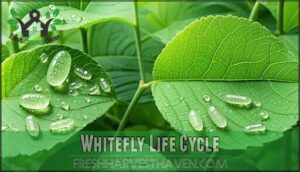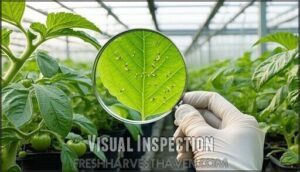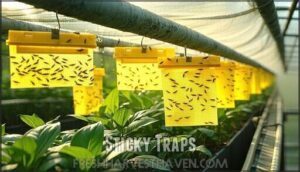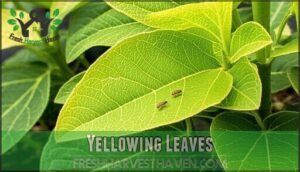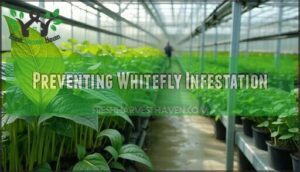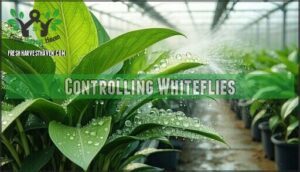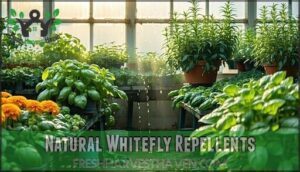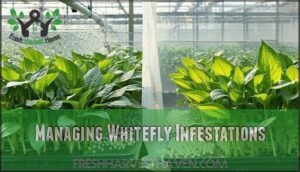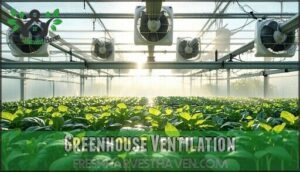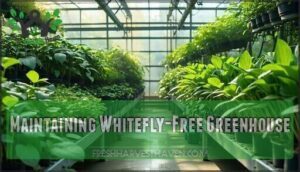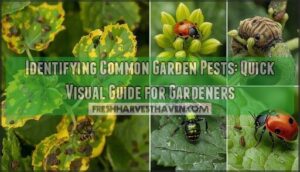This site is supported by our readers. We may earn a commission, at no cost to you, if you purchase through links.

Start by installing fine mesh screens on vents and openings to block adult whiteflies from entering. Maintain strict sanitation by removing plant debris and controlling weeds that serve as breeding grounds.
Inspect new plants thoroughly before introducing them to your greenhouse—quarantine suspicious specimens for at least two weeks. Deploy yellow sticky traps to monitor adult populations and catch early infestations.
Regular visual inspections of leaf undersides help detect eggs and nymphs before populations explode. Keep your greenhouse well-ventilated to create conditions whiteflies dislike.
These foundational strategies form your first line of defense, but there’s more to master.
Table Of Contents
- Key Takeaways
- What Are Whiteflies
- Whitefly Life Cycle
- Identifying Whiteflies
- Whitefly Damage Signs
- Preventing Whitefly Infestation
- Controlling Whiteflies
- Natural Whitefly Repellents
- Managing Whitefly Infestations
- Greenhouse Ventilation
- Maintaining Whitefly-Free Greenhouse
- Frequently Asked Questions (FAQs)
- How do you prevent whitefly infestation?
- What is the best repellent for whiteflies?
- What are the predators of the greenhouse whitefly?
- What is a homemade solution for whiteflies?
- How do you get rid of whiteflies in a greenhouse?
- How do I prevent whiteflies?
- Do whiteflies die in a greenhouse?
- How do you get rid of white flies indoors?
- Why do whiteflies grow in greenhouses?
- Do white flies live in greenhouses?
- Conclusion
Key Takeaways
- Install fine mesh screens and maintain strict sanitation – Block adult whiteflies from entering through vents and eliminate breeding grounds by removing plant debris and controlling weeds that harbor these pests.
- Quarantine new plants and conduct regular inspections – Isolate suspicious specimens for two weeks before introducing them, and check leaf undersides twice weekly to catch eggs and nymphs before populations explode.
- Deploy yellow sticky traps and ensure proper ventilation – Position traps every 250 square feet to monitor adult populations, while maintaining airflow that disrupts whitefly flight patterns and breeding cycles.
- Use integrated control methods when infestations occur – Combine organic sprays like neem oil and insecticidal soap with biological controls such as beneficial insects to target different life stages effectively.
What Are Whiteflies
Whiteflies are tiny, soft-bodied insects that belong to the Hemiptera order and are closely related to aphids and mealybugs, not true flies.
You’ll recognize these greenhouse pests by their distinctive white waxy wing coating and their habit of clustering on the undersides of plant leaves where they feed on plant sap.
Whitefly Identification
While whiteflies might look like tiny moths fluttering around your greenhouse, they’re actually sap-sucking insects from the Hemiptera order.
These greenhouse pests are easy to spot once you know what you’re looking for.
Once you know their telltale signs, whiteflies become unmistakable greenhouse invaders.
Here’s what to watch for during pest monitoring:
- Adult features: White, powdery wings measuring 1-2mm with triangular body shape
- Nymph identification: Translucent, oval discs clinging to leaf undersides
- Egg appearance: Cone-shaped clusters arranged in crescent patterns on newest leaves
- Species variations: Greenhouse whiteflies show subtle wing markings that help distinguish different types
Distinguishing whiteflies from other pests becomes easier when you understand their unique characteristics and behavior patterns in greenhouse environments.
Whitefly Lifecycle
Once you’ve spotted these tiny greenhouse invaders, you’ll want to understand their reproductive strategy to stay one step ahead.
The whitefly life cycle spans approximately 25-30 days under ideal greenhouse conditions, making rapid population explosions your biggest challenge.
Here’s what makes their lifecycle so problematic for greenhouse managers:
- Egg Development – Each female deposits 200-400 cone-shaped eggs in crescent patterns on leaf undersides
- Nymphal Instars – Four distinct growth stages where larvae feed continuously on plant sap
- Honeydew Production – Nymphs excrete sticky substances that attract sooty mold and ants
- Adult Longevity – Mature whiteflies live 30-40 days, continuously reproducing
- Mating Habits – Adults begin reproducing within days of emergence, creating overlapping generations
This overlapping lifecycle means you’ll face eggs, nymphs, and adults simultaneously, requiring targeted control strategies for each stage.
Whitefly Damage
Sap sucking damage accelerates rapidly once these pests establish themselves in your greenhouse.
Once whiteflies take hold, your greenhouse plants face relentless attack from these tiny sap-sucking invaders.
You’ll witness plant decline through nutrient loss as whiteflies extract essential fluids, creating leaf lesions that invite bacterial infections.
Their sticky honeydew effects attract sooty mold, while whitefly damage signs include yellowing foliage and stunted growth.
Implementing whitefly damage prevention and whitefly monitoring systems helps protect your crops from devastating yield losses.
Whitefly Life Cycle
Understanding the whitefly life cycle helps you target them at their most vulnerable stages.
You’ll see three distinct phases: egg, nymph, and adult, each requiring different control strategies for effective greenhouse management.
Egg Stage
Female whiteflies launch their reproductive assault by depositing eggs on leaf undersides, creating the foundation for future infestations.
Understanding the egg stage helps you intercept these pests before they establish colonies in your greenhouse environment.
During the incubation period, proper identification becomes vital for effective whitefly egg smothering techniques.
The fertilization process guarantees viable offspring that’ll progress through whitefly lifecycle stages.
- Egg laying occurs in distinctive crescent patterns on newest foliage
- Whitefly eggs change from burnt orange to dark gray during development
- Egg hatching happens within 5-10 days under ideal greenhouse conditions
- Egg stage vulnerability offers your best intervention opportunity before population explosion
Nymphal Stages
After eggs hatch within 5-7 days, you’ll encounter four distinct instar stages of nymph development.
These whitefly nymphs start as mobile crawlers before settling into their feeding behavior pattern. During the stationary phases, they extract plant sap and excrete sticky honeydew waste.
The molting process between each stage creates temporary vulnerability windows for targeted whitefly control methods. Nymphal growth progresses from 0.3mm to 0.7mm across these nymphal stages, making later instars easier to spot during your whitefly lifecycle monitoring routine.
Understanding natural whitefly remedies is essential for effective management of these pests.
Adult Stage
After their final molt, adult whiteflies emerge with powdery white wings and begin their reproductive phase.
These mature insects live 30-40 days, during which whitefly mating occurs and females deposit hundreds of eggs.
Adult behavior includes dispersing when disturbed, making whitefly traps effective for whitefly control methods.
Their feeding habits continue producing honeydew, while wing structure enables flight between host plants.
Understanding adult longevity helps time whitefly prevention methods and whitefly species identification for targeted control.
Identifying Whiteflies
You’ll need to spot whiteflies early before they establish a foothold in your greenhouse ecosystem. Three reliable detection methods help you catch these tiny pests during their most vulnerable stages.
Visual Inspection
Start your visual inspection by examining leaf undersides where whiteflies congregate. Look for tiny white-winged adults that scatter when disturbed, translucent oval nymphs, and cone-shaped eggs in crescent patterns.
Focus your pest scouting on susceptible plants like tomatoes and peppers during routine plant examination. Use a magnifying glass to spot early infestation signs before populations explode.
Regular leaf checks help you catch these sneaky pests before they establish colonies throughout your greenhouse. For more accurate inspections, understanding magnifying glass techniques is essential to identify whiteflies effectively.
Sticky Traps
Yellow sticky traps serve as your early warning system for detecting whitefly populations before they establish colonies.
Position these bright yellow sticky cards at plant height throughout your greenhouse, spacing them every 250 square feet for maximum trap efficacy. The vibrant color attracts adult whiteflies, who become permanently stuck when investigating.
Check your sticky trap placement weekly and replace saturated traps to maintain trap effectiveness. This trap maintenance routine helps you monitor population levels and catch infestations early, preventing costly plant damage.
Effective whitefly control often relies on using sticky trap products to capture and remove adult whiteflies from the greenhouse environment, which is a crucial step in maintaining a healthy greenhouse ecosystem and preventing costly plant damage.
Honeydew Signs
Beyond sticky traps, honeydew signs reveal whitefly presence before populations explode.
These sweet secretions create sticky leaves that feel tacky when touched, signaling active feeding activity.
Honeydew drops accumulate on surfaces below infested plants, creating perfect conditions for black fungus development.
Effective sticky trap methods can also aid in whitefly control.
Watch for these honeydew signs:
- Sticky residue coating leaf surfaces and greenhouse floors
- Black sooty mold growing on honeydew deposits
- Increased ant activity attracted to sweet secretions
- Reflective droplets visible when viewing plants from different angles
Prompt honeydew removal prevents sooty mold establishment and reduces ant populations that protect whiteflies from natural predators.
Whitefly Damage Signs
Recognizing whitefly damage early helps you protect your greenhouse plants before infestations spiral out of control.
You’ll notice three primary warning signs that indicate these tiny pests have invaded your growing space.
Yellowing Leaves
Damage becomes evident when you notice your once-vibrant plants displaying yellowing leaves – a clear indicator of whitefly damage.
These pests cause plant stress through continuous plant nutrient extraction, leading to chlorosis symptoms and eventual leaf drop.
| Damage Stage | Visual Signs | Plant Response |
|---|---|---|
| Early | Light yellow spots | Reduced photosynthesis |
| Moderate | Widespread yellowing | Nutrient deficit symptoms |
| Severe | Leaf damage with drop | Complete defoliation |
| Critical | Brown, crispy edges | Plant death possible |
| Recovery | New green growth | Gradual improvement |
Honeydew secretion compounds problems by attracting sooty mold.
Stunted Growth
After initial yellowing appears, stunted growth becomes your next major concern with whitefly infestations.
These pests create hormone imbalance by disrupting essential plant functions, leading to shorter stems and reduced leaf development.
Plant stress from continuous sap feeding causes nutrient deficiency and leaf distortion throughout your greenhouse.
Effective whitefly prevention through plant nutrient management and greenhouse whitefly control helps maintain normal growth patterns.
Preventing whiteflies early protects against these growth retardants that compromise your plants’ potential.
Black Sooty Mold
Whitefly honeydew creates the perfect breeding ground for black sooty mold, a fungal disease that coats leaves in dark, unsightly patches.
This black fungus blocks sunlight and hampers photosynthesis, weakening your plants further.
Effective mold prevention requires immediate whitefly control and sooty mold removal.
- Remove honeydew residue with gentle water spraying
- Implement strict greenhouse hygiene practices
- Apply fungicidal treatments for severe mold control
- Monitor regularly for early fungal diseases detection
Preventing Whitefly Infestation
Prevention starts with creating an environment where whiteflies can’t establish themselves in your greenhouse.
You’ll need to focus on three key strategies: maintaining strict sanitation protocols, installing proper screening systems, and conducting regular plant inspections to catch problems early.
Greenhouse Sanitation
Cleanliness creates the foundation for effective whitefly control in your greenhouse environment. Start your pest prevention routine by establishing thorough sanitation methods that target all surfaces where pests might harbor. Disinfection tips include using diluted bleach solutions on benches, floors, and tools between plant rotations.
Implement strict plant quarantine protocols for new arrivals, keeping them isolated for two weeks. Your greenhouse hygiene practices should include removing fallen leaves immediately and maintaining clean walkways. Consider reflective mulch around plants to confuse flying adults.
| Sanitation Task | Frequency | Tools Required |
|---|---|---|
| Surface disinfection | Weekly | Bleach solution, spray bottles |
| Tool sterilization | After each use | Alcohol wipes, sanitizer |
| Waste management | Daily | Collection bins, disposal bags |
| Equipment cleaning | Monthly | Cleaning tools, brushes |
These sterilization techniques create an inhospitable environment for whitefly development while supporting healthy plant growth.
Insect Screens
Install fine mesh screens (0.2-0.3mm mesh size) over all greenhouse openings to block whitefly entry.
Choose durable fiberglass over cheaper polyethylene netting for longevity. Proper frame designs guarantee screens fit snugly without gaps.
Check installation tips for secure mounting and perform regular maintenance checks to repair tears or loose sections that compromise protection.
To further prevent infestations, understanding whitefly control methods is essential for maintaining a healthy greenhouse environment.
Regular Inspections
Beyond keeping bugs out, your regular inspections serve as your early warning system against whitefly invasions. Think of visual checks as your greenhouse’s security patrol—catching problems while they’re still manageable rather than when they’ve reached epidemic proportions.
Conduct regular scans twice weekly using proper inspection tools like magnifying glasses for thorough plant inspection. This pest monitoring routine enables early detection before populations explode.
- Focus on leaf undersides where whitefly identification becomes critical for greenhouse pest management
- Document findings in a logbook with dates, temperatures, and observed populations
- Check yellow sticky traps weekly, counting captures to establish action thresholds
- Prioritize vulnerable plants like tomatoes and newly introduced specimens
These preventative measures transform reactive panic into proactive management, keeping your greenhouse ecosystem balanced and productive.
Controlling Whiteflies
When whiteflies establish themselves in your greenhouse, you’ll need targeted control methods to eliminate the population and protect your plants.
These three proven approaches work by attacking different life stages and can be combined for maximum effectiveness against stubborn infestations.
Organic Sprays
When prevention falls short, organic sprays become your first line of defense. Neem oil disrupts whitefly reproduction, while insecticidal soap breaks down their protective waxy coating on contact.
| Spray Type | Application Rate | Effectiveness |
|---|---|---|
| Neem Oil | Weekly intervals | 80% reduction |
| Insecticidal Soap | Every 3-5 days | Immediate knockdown |
| Horticultural Oils | Bi-weekly | All life stages |
Rotate between horticultural oils and biological sprays to prevent resistance development in your organic whitefly control program.
Biological Controls
While organic sprays provide quick knockdown, biological whitefly control offers sustainable, long-term protection through nature’s own pest management system.
Beneficial insects create a living defense network in your greenhouse. Parasitic wasps like Encarsia formosa lay eggs inside whitefly nymphs, turning them into biological factories. Ladybug introduction brings voracious appetites that consume hundreds of whitefly eggs daily, while lacewing control targets both eggs and young nymphs with precision.
Here’s your biological arsenal:
- Encarsia formosa – parasitic wasps for targeted whitefly elimination
- Delphastus catalinae – predatory beetles that devour eggs and larvae
- Beauveria bassiana – fungal pathogens that penetrate whitefly cuticles
Release beneficial insects when temperatures stay between 70-80°F for ideal activity.
Insecticidal Soaps
Insecticidal soaps target whitefly soft bodies through direct contact, disrupting their cellular structure effectively. These potassium-based formulations offer excellent soap effectiveness when applied correctly.
Soap concentration matters—follow manufacturer guidelines for safe dilution ratios to avoid plant damage.
- Apply during cooler morning or evening hours for maximum soap timing
- Use thorough spray techniques covering leaf undersides where whiteflies congregate
- Choose soap ingredients specifically designed for greenhouse pest control
Proper application methods guarantee maximum contact with target pests while protecting your plants.
Natural Whitefly Repellents
Natural repellents offer an eco-friendly approach that keeps whiteflies away without harsh chemicals or disrupting beneficial insects in your greenhouse.
You can create a protective barrier using companion plants, essential oil sprays, and strategically placed repellent species that naturally deter these persistent pests.
Companion Planting
Through strategic plant partnerships, you’ll create a living shield against whiteflies.
Marigolds reduce populations by 60% in greenhouse trials, while nasturtium effects include attracting beneficial predators like ladybugs.
Basil and mint serve as powerful natural deterrents, releasing volatile oils that disrupt whitefly behavior.
These repellent plants work by masking host plant odors and creating chemical barriers.
Marigold benefits extend beyond pest control—they’re your greenhouse’s bodyguards, standing sentinel while you focus on growing healthy crops.
Effective whitefly control also involves understanding whitefly life cycles to target their weaknesses.
Essential Oils
Eucalyptus oil and peppermint oil create powerful barriers against whiteflies in your greenhouse.
Mix neem oil with water for foliar sprays that disrupt feeding behavior.
Tea tree oil and lemon extract work as natural repellents when applied weekly.
These essential oils target adult whiteflies’ nervous systems, causing paralysis.
Combine multiple oils for enhanced protection—eucalyptus spray pairs well with peppermint for maximum effectiveness.
Repellent Plants
Beyond essential oils, repellent plants create a living barrier against whiteflies.
These natural deterrents work around the clock, releasing compounds that whiteflies find offensive while attracting beneficial insects to your greenhouse.
- Marigold benefits include powerful scent compounds that repel whiteflies naturally
- Nasturtium effects trap pests while serving as sacrificial companion plants
- Repellent herbs like basil and mint double as culinary ingredients
- Plant companions create diverse ecosystems that naturally discourage infestations
Managing Whitefly Infestations
When whiteflies establish themselves in your greenhouse, swift action prevents small problems from becoming major infestations.
You’ll need to implement quarantine measures, remove heavily damaged plants, and eliminate weeds that serve as breeding grounds for these persistent pests, which is crucial for preventing the spread of infestations.
Quarantine Procedures
Success in preventing whiteflies begins with rigorous quarantine procedures. You’ll need thorough plant inspection and proper isolation methods before introducing new seedlings into your whitefly free greenhouse.
Implement strict entry protocols and sanitation procedures to maintain control. This is crucial for preventing the introduction of whiteflies into your greenhouse.
| Quarantine Task | Action Required | Timeline |
|---|---|---|
| Initial Inspection | Check all plant surfaces for eggs/nymphs | Day 1 |
| Isolation Setup | Place in separate quarantine area | Day 1 |
| Daily Monitoring | Document any pest activity | Days 1-14 |
| Decontamination | Clean tools between plant handling | Daily |
| Final Assessment | Clear for greenhouse entry | Day 14 |
This systematic approach guarantees new seedlings inspection prevents contamination of your established plants. By following these steps, you can ensure a whitefly free greenhouse and maintain a healthy environment for your plants through proper isolation methods and daily monitoring.
Destroying Infested Plants
When your greenhouse plants show severe whitefly infestation, destroying infested plants becomes essential for pest eradication and disease prevention.
Remove heavily damaged specimens immediately to protect healthy crops. Don’t compost these plants—infestation removal requires burning or deep burial to prevent recontamination.
After plant disposal, treat surrounding vegetation with neem oil for greenhouse whitefly treatment. This decisive action protects your remaining plants and maintains a whitefly free greenhouse through proper crop protection strategies.
Weed Control
The foundation of effective weed management starts with proper weed identification and systematic removal strategies.
Weeds serve as alternative hosts for whiteflies, creating hidden breeding grounds that undermine your pest control efforts.
Implementing thorough weed control measures substantially reduces whitefly populations by eliminating these refuge sites.
Here’s your strategic approach to weed management:
- Weed identification – Map problem species for targeted control
- Manual removal – Extract weeds before they establish breeding sites
- Herbicide options – Apply selective treatments for persistent infestations
- Soil preparation with solarization to eliminate dormant seeds
- Crop rotation combined with barrier methods and mulch application
Consistent weed removal prevents infestations while maintaining ideal growing conditions.
Effective organic weed control techniques are vital for long-term whitefly management.
Greenhouse Ventilation
Proper greenhouse ventilation creates air movement that disrupts whitefly flight patterns and makes it harder for these pests to establish colonies on your plants.
You’ll need to balance fresh air circulation with maintaining ideal growing conditions while keeping unwanted insects from entering your greenhouse space, which is crucial for greenhouse ventilation.
Natural Ventilation
Effective air flow creates the foundation for whitefly prevention through natural ventilation.
Your greenhouse ventilation system should include strategically placed intake and exhaust vents that promote airflow optimization.
This passive approach maintains temperature regulation and humidity control without electricity costs.
Proper air movement disrupts whitefly breeding cycles while keeping plants healthy through consistent climate control.
Fan Installation
Strategic fan installation creates powerful air currents that disrupt whitefly behavior patterns. Position circulation fans to achieve 0.2-0.5 m/s airflow at plant level for effective whitefly deterrence.
Essential fan installation steps:
- Mount horizontal airflow fans for uniform air distribution throughout greenhouse zones
- Install exhaust fans near entry points to prevent whitefly ingress during door openings
- Position ceiling fans to eliminate stagnant air pockets where whiteflies typically congregate
- Space circulation fans with overlapping airflow patterns for complete canopy coverage
- Integrate automated controls with environmental sensors for energy-efficient ventilation systems operation
Screen Maintenance
Inspect your greenhouse insect screens weekly for tears, gaps, or warped frame materials that compromise insect barriers.
Clean screens monthly using mild soap and water to maintain proper airflow through ventilation systems. Replace damaged sections immediately—even small holes allow whiteflies inside.
Choose appropriate mesh size for your climate while ensuring material durability. Proper screen maintenance keeps your insect screening effective year-round.
Maintaining Whitefly-Free Greenhouse
Maintaining a whitefly-free greenhouse requires three essential ongoing practices that’ll keep your growing space productive year-round.
You’ll need to establish consistent monitoring schedules, maintain strict sanitation protocols, and stay updated on the latest integrated pest management techniques to prevent costly infestations before they establish.
Regular Monitoring
Effective ventilation sets the stage, but consistent whitefly monitoring keeps your greenhouse pest-free.
Daily checks and routine scans help you spot problems before they spiral out of control.
Regular inspections involve systematic plant inspection and strategic trap placement throughout your growing space.
You’ll catch early signs like yellowing leaves that signal whitefly activity.
- Check yellow sticky traps twice weekly for adult captures
- Examine leaf undersides during daily checks for eggs and nymphs
- Document findings in a pest tracking log with dates and locations
- Focus frequent observations on new plants and vulnerable species
Continuous Sanitation
Maintaining cleanliness isn’t just good housekeeping—it’s your frontline defense against whiteflies. Daily sanitation practices create an unwelcome environment for these persistent pests.
| Sanitation Methods | Cleaning Schedules |
|---|---|
| Surface disinfection | Daily equipment wipe-down |
| Tool sterilization | Weekly deep clean |
| Waste Management | Monthly facility review |
| Disinfection Techniques | Seasonal overhaul |
Your greenhouse sanitation routine should include removing plant debris, sterilizing tools between uses, and sanitizing surfaces with approved cleaners. Proper waste management prevents breeding sites, while systematic sterilization procedures eliminate hidden eggs and larvae that monitoring might miss.
Ongoing Education
Beyond keeping your greenhouse clean, staying informed through ongoing education guarantees you’re equipped with the latest whitefly prevention strategies and integrated pest management techniques.
Keep your knowledge current by exploring:
- Education Resources – Subscribe to horticultural journals and extension publications
- Training Workshops – Attend local greenhouse management seminars and pest control sessions
- Online Courses – Complete certification programs in integrated pest management
- Research Updates – Follow university studies on whitefly prevention strategies
- Seminar Topics – Join discussions on emerging greenhouse pest control methods
This continuous learning approach helps you implement cutting-edge pest management techniques effectively.
Frequently Asked Questions (FAQs)
How do you prevent whitefly infestation?
Preventing pesky pests starts with proper preparation.
You’ll want to quarantine new plants, maintain clean greenhouse conditions.
Install yellow sticky traps for early detection, and regularly inspect leaf undersides for eggs or nymphs to catch infestations before they spread, which is crucial for preventing pesky pests.
What is the best repellent for whiteflies?
Essential oils like neem and peppermint work best as whitefly repellents.
You’ll also get excellent results planting marigolds, nasturtiums, and calendula around your greenhouse—they naturally deter these pests while attracting beneficial insects.
What are the predators of the greenhouse whitefly?
While greenhouse whiteflies terrorize your plants, nature provides powerful allies.
Lacewings, minute pirate bugs, ladybugs, and parasitic wasps like Encarsia formosa actively hunt these pests, controlling populations effectively through biological warfare.
What is a homemade solution for whiteflies?
Mix one tablespoon of mild dish soap with one quart of water to create an effective spray that suffocates whitefly adults and nymphs on contact through their soft bodies.
How do you get rid of whiteflies in a greenhouse?
With females laying up to 400 eggs each, you’ll need multiple tactics.
Use yellow sticky traps, spray insecticidal soap weekly, introduce beneficial insects like ladybugs.
Maintain proper sanitation by removing infected plant debris immediately.
How do I prevent whiteflies?
Quarantine new plants for two weeks before introducing them to your greenhouse.
Install fine mesh screens on vents, maintain clean growing areas, and place yellow sticky traps strategically to catch adults early.
Do whiteflies die in a greenhouse?
Whiteflies won’t naturally die in your greenhouse environment – they’ll actually thrive year-round since they can’t survive freezing outdoor temperatures but find perfect conditions indoors.
How do you get rid of white flies indoors?
Unlike outdoor gardens where nature helps balance pests, indoor spaces trap whiteflies.
Use yellow sticky traps, spray insecticidal soap weekly, vacuum adults gently, and quarantine new plants to break their lifecycle effectively.
Why do whiteflies grow in greenhouses?
Greenhouses create perfect conditions that whiteflies crave: warm temperatures, high humidity, and abundant host plants.
You’ve basically built them a paradise where they’ll multiply rapidly without natural predators or weather disruptions, which is why whiteflies thrive in such environments.
Do white flies live in greenhouses?
Yes, whiteflies absolutely live in greenhouses year-round.
They thrive in the warm, controlled environment you’ve created.
Unlike outdoor conditions, your greenhouse provides constant temperatures that prevent these pests from dying off seasonally, allowing them to thrive year-round.
Conclusion
Success in preventing whiteflies in greenhouse environments isn’t rocket science—it’s about consistency and vigilance.
You’ve learned seven proven methods that work when applied systematically.
Remember, prevention beats treatment every time.
Install screens, maintain sanitation, inspect regularly, and use monitoring traps.
Keep your greenhouse well-ventilated and quarantine new plants.
These strategies create an inhospitable environment for whiteflies.
Stay proactive, and you’ll enjoy healthy, pest-free crops year-round.

